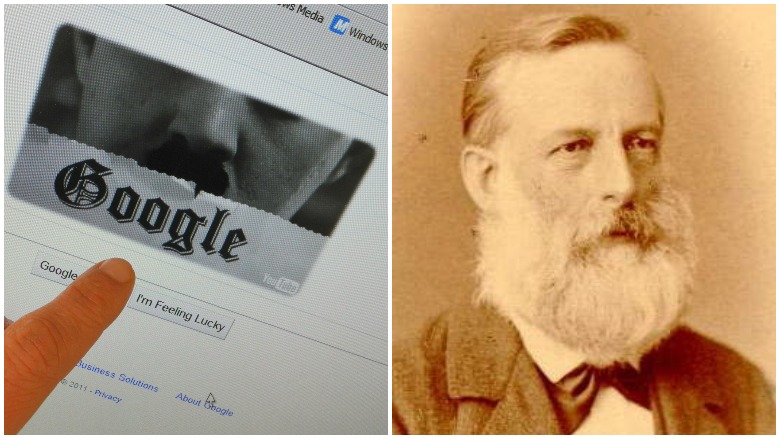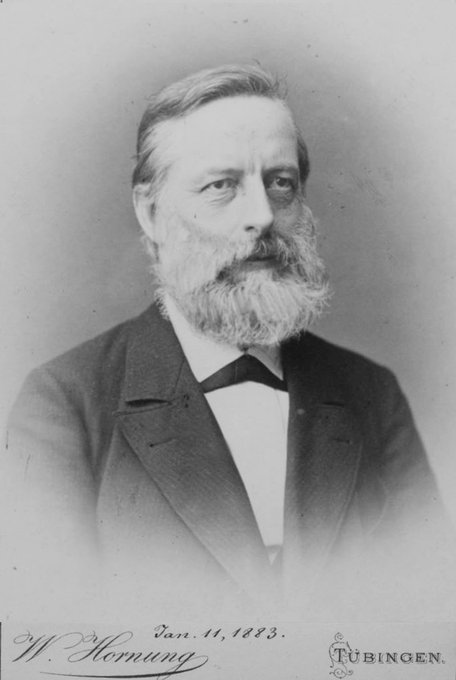
Wikimedia Commons/Getty Julius Lothar Meyer/A Google Doodle for Charlie Chaplin
Julius Lothar Meyer was a German chemist who was instrumental in the creation of the first periodic table of elements. Meyer is featured on today’s Google Doodle, celebrating his 190th birthday August 19, 2020.
The Google Doodle depicts Lothar Meyer in the lab, in an illustration featuring his iconic beard and his graph, the Lothar Meyer arrangement. Lothar Meyer died at age 64 on April 11, 1895, but he would have been 190 today. He was born August 19, 1830, in Varel, Oldenburg, Germany.
“Happy birthday, Julius Lothar Meyer, and thank you for braving the elements for the sake of scientific knowledge!” Google writes.
Lothar Meyer never took credit for publishing the first periodic table of elements. Russian chemist Dimitri Mendeleev is widely credited with its creation in 1870. However, Lothar Meyer printed a preliminary scheme to arrange the elements by atomic weight in 1864, six years before Mendeleev.
Here’s what you need to know:
1. Julius Lothar Meyer Was Educated As a Physicist & Became a Chemistry Professor
Julius Lothar Meyer was educated as a physicist, but he became known in history for his groundbreaking work in chemistry – laying the foundation for the periodic table of elements. His interests primarily lay in chemistry and physics. Lothar Meyer was born Aug. 19, 1830, in Varel, Oldenburg, Germany, and died April 11, 1895, at age 64 in Tübingen, Germany, according to Brittanica.
Lothar Meyer worked as a science educator beginning in 1859, and was appointed to several positions before he became a chemistry professor at the University of Tübingen. He died in the university town where he worked as a professor.
“Though originally educated as a physician, he was chiefly interested in chemistry and physics,” Brittanica said. “In 1859 Meyer began his career as a science educator, holding various appointments before serving as professor of chemistry at the University of Tübingen (1876–95).”
2. Julius Lothar Meyer Arranged Elements by Atomic Weight in His Book, ‘Die modernen Theorien der Chemie,’ or ‘Modern Chemical Theory’
Julius Lothar Meyer published a book, “Die modernen Theorien der Chemie,” or “Modern Chemical Theory,” in 1864. The book was a lucid treatise on the fundamental principles of chemical science, according to Britannica. It also contained a preliminary scheme for the arrangement of elements by atomic weight, and discussed the relation between the atomic weights and the properties of those elements.
Lothar Meyer’s work on the periodic table was influential. The preliminary scheme was enlarged and reprinted in many editions. He published an expanded table in 1868, which was similar to the periodic table of elements produced by Russian chemist Dimitri Mendeleev in 1870, according to Brittanica.
“This influential work was often enlarged and went into many editions,” Brittanica wrote. “In about 1868 Meyer prepared an expanded table, similar in many ways to Mendeleyev’s table published in 1869.”
3. Russian Chemist Dimitri Mendeleev Is Widely Credited With the Development of the Periodic Table of Elements & Julius Lothar Meyer Did Not Take Credit for It
The development of the first periodic table of elements is widely credited to Dimitri Mendeleev, a Russian chemist who started the development of the periodic table of elements in 1869, according to Lenntech. This was five years after Julius Lothar Meyers preliminary scheme arranging elements by atomic weight was published in 1865. It was called the Lothar Meyer arrangement, or the Meyer graph.
“In 1869 Russian chemist Dimitri Mendeleev started the development of the periodic table, arranging chemical elements by atomic mass. He predicted the discovery of other elements, and left spaces open in his periodic table for them,” Lenntech wrote on its periodic table history.
Lothar Meyer worked independently of Mendeleev in developing his periodic classification of chemical elements. Although the preliminary work appeared in his publication, he did not publish his table until 1870, one year after Mendeleev, according to Brittanica.
“He did not claim priority for his achievement, and he admitted that he had been reluctant to predict the existence of undiscovered elements as Mendeleyev had done,” Brittanica said.
4. Julius Lothar Meyer & Dimitri Mendeleev Were Jointly Awarded the Davy Medal for the Periodic Table of Elements
Both Julius Lothar Meyer and Dimitri Mendeleev received the high honor of the Royal Society’s Davy Medal for their work on the periodic table of elements in 1882. The Davy Medal is awarded annually for research in chemistry. The first Davy Medal was awarded in 1877 to Humphry Davy FRS, the inventor of the Davy Lamp.
The Royal Society’s Davy Medal past winners lists “D Mendelejeff and Lothar Meyer” “For their discovery of the periodic relations of the atomic weights.”
Kelling Donald wrote about the politics behind the credit for the periodic table for “The Conversation” in “The politics of the periodic table – who gets the credit and why“.
“Indeed, the joint award has been cited as evidence that what was seen by some to be especially valuable about Mendeleev’s table was how it accommodated (as Meyer’s also did) the elements that were known, and not so much for Mendeleev’s predictions of new elements,” Donald wrote. “Was the Royal Society hoping too, through the joint award, to muffle the disquiet about priority or credit for the increasingly indispensable table? Perhaps. But if that were the intention, they failed. In science as in politics, the temptation to be simple rather than accurate can be quite strong. Scientists still say, ‘Mendeleev discovered the periodic table.'”
5. An Article Published Several Months After Lothar Meyer’s Death Said the Lothar Meyer Arrangement Was Developed Independently of Dimitri Mendeleev
An article published in 1895 in the “Scientific American, a few months after Lothar Meyer’s death, attributed much of the credit for the periodic table of elements to Dimitri Mendeleev. However, it also said Meyer developed his concepts on periodic law independent of Mendeleev. The article, written by chemist M. M. Pattison Mui, also discussed the controversy between Mendeleev and Meyer, and their groundbreaking discoveries.
“The clear enunciation, and the application in detail, of the most far-reaching generalization that has been made in chemistry since the work of Dalton, must, undoubtedly, be credited to that great chemist Mendeleev,” the article said.
Pattison Mui continues, “Nevertheless, a perusal of the controversy between Mendeleev and Meyer shows, I think, that Meyer arrived at the fundamental conception of the periodic law independently of Mendeleev.”
READ NEXT: Edward Snowden Now: Where Is the NSA Whistleblower Today in 2020?


